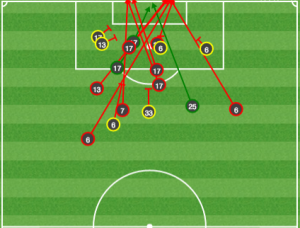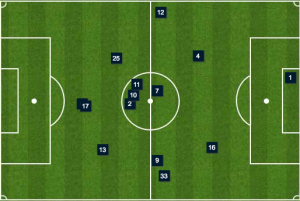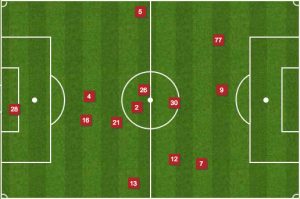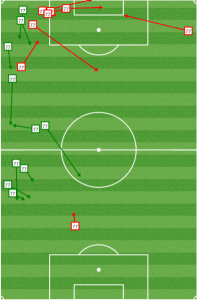Photo: Courtesy of Philadelphia Union
There was a fear in the offseason that can be summed up by this question: What do we do if the Union are just… bad again?
Luckily, Philly has not been a bad team. But they are a young team. With injuries to three top players. And MLS debutants in key positions. And a goalie in his first season as the number one. And the same holding midfielder as DC United circa 2004.
So when they struggle to deal with novel conditions and a team that plays an oddly deep defensive shape at home, you have to cut them some slack. In wild weather, Chicago’s well-organized defensive shell proved too much for the Union. Despite planting three kisses on the woodwork, Philly ran out of gas and ideas after Warren Creavalle’s straight red card.
Straight red? Really?
Creavalle was gone after that tackle. Two yellows, straight red, it doesn’t matter. Moving on.

Union shots. That’s, um, a lot from low percentage areas. And a lot of blocks in the box for Chicago.
Was one team better?
Not really. But Chicago’s ability to change tactics while maintaining the same goals was impressive, while the Union’s commitment to their own tactics was intriguing for different reasons.
The new breed of soccer coaches tends to embrace one of two broad philosophies: Either dominate a match with your own tactics and shape, such that teams can know what’s coming but still struggle to deal with it; or define clear goals within the match, but introduce flexibility in shape and approach that makes it harder for the opposition to decipher how you will reach those goals. Earnie Stewart and, by extension, Jim Curtin are in the first camp. Veljko Paunovic appears to be in the latter.
Although the Fire have played three-man defenses for much of the season, Paunovic laid out a 4-4-2 that seemed to take weather conditions and the Union’s tactics into account. Philly has had success playing a compact, high press out of a 4-3-3 shape that tucks wingers inside offensively but asks them to track opposing fullbacks. Like any system, this one has weaknesses and strengths. One major strength is that it can force central defenders to act like point guards, picking out the right forward passes and playing long, ground passes into tight areas. For many CBs, this is quite difficult, and Chicago’s duo struggled in the first half with only two completed passes into the middle.
Stretched midfield
But in the past two matches, the Union have been able to press without getting stretched. Behind CJ Sapong, the attacking midfielder and two holders have stayed relatively close together, allowing Philly to jam up the center and prevent passes into holes between midfield and defense. On Saturday, however, the Union made the odd decision to press Chicago’s central defenders with Sapong and Roland Alberg, meaning the midfield got stretched, and Razvan Cocis — a good player but far below the quality of Lee Nguyen and Federico Higuain (thank goodness) — was able to find spaces between the lines to attack. Cocis rarely took advantage of this, often settling for easy passes to the flank. These are fine in typical conditions, but left the Fire with few good options with the early April wind adding an element of randomness to everything in the air. If Cocis had turned toward goal and attacked more often, Philly would have had far more trouble holding off the Fire.
[gfycat data_id=”FabulousPlayfulBasilisk” data_autoplay=false data_controls=false data_title=true]

Alberg (No. 6, under Sapong) operated higher than usual and Creavalle (2) had a huge space to cover.
When Philly’s midfield shape is good, it resembles something like a drunken triangle. The shape can be ugly in aggregate, but in practice it reflects the notion that pressure on the ball is consistently supported by pressure on the ball carrier’s main options (or pressure on the ball directs the ball carrier into specific areas of the pitch). Against Chicago, the Union’s pressure was less organized than in past encounters, with Alberg’s high press and Carroll’s deep positioning (to ice out Gilberto) leaving Creavalle with enormous spaces to defend. Creavalle closes space as fast as anybody, but far too much was asked of him on Saturday.
The cards he accumulated and the gaps Cocis exploited could be indicative of an off-day or regression to the mean in Creavalle’s performances. But they looked far more like the holes that appear when a three-man midfield comes to resemble a vertical line rather than a triangle. And, notably, the average positions of Carroll, Creavalle, and Alberg suggest that the latter was more disconnected from his compatriots than against New England.

Chicago’s central defenders (4 & 16) rarely strayed from the middle, creating a similar shape to a 3-man back line.
Why the 4-4-2?
But let’s take a step back: Why did Paunovic opt for two central defenders when his team has done so well defensively with three in the back? First, as some commenters noted on the PSP preview, it often pays to have an extra body in midfield. And as the average position of Chicago’s defense shows, even though they played with four defenders, their shape resembled one with three central defenders, with the CBs staying very central and the wingbacks pushed high and wide.
Second, Paunovic likely figured that a high press would make it more difficult for his defenders to advance the ball into dangerous positions (the Fire looked far more fluid when Campbell was able to cross midfield before finding a pass). Chicago looked to set up simple, short passes into Matt Polster and Michael Stephens that had the same effect as a defender dribbling forward. It forced a winger to tuck inside defensively and asked questions of the fullbacks, who then had to decide whether to pressure the Fire’s fullbacks/wingbacks or hold their position in the back line.
Third, the Fire did not believe Philly would effectively send runners through the center, meaning that a three-man defense would end up being a 3v1 on Sapong.
Fourth, and finally, Chicago wanted to be able to support their own fullbacks on both sides with mobile midfielders because the Union’s wingers rarely get in behind, but they can be dangerous collecting the ball in the middle third. Basically, the Fire were willing to change shape to match the Union, but their defensive and offensive goals remained largely the same.
Essentially, the Fire want to make sure they keep central defenders in the box when the ball gets into the final third. The Union often end up with Richie Marquez and Ken Tribbett chasing into corners because Philly’s fullbacks are extremely aggressive tracking players on the flanks, and somebody has to fill that space in behind.
The Fire do not want their CBs out there in space. A three-man defense is designed to keep teams from attempting those early balls into corners, since there is always a defender keeping an eye on the space. Saturday’s more traditional four-man defense left the deep spaces more open, but put quick pressure on Philly’s wingers when they got the ball.
Notably, Pontius and Ilsinho adjusted quite well to this pressure, floating into good spaces between the lines and moving for the ball. However, a static and crowded central midfield meant there were few options and little time to find them. Ilsinho, in particular, was able to create out of difficult positions, but just think about how effective he would have been if he’d been able to play short passes into the center then move off the ball.
[gfycat data_id=”HardtofindUnlinedFiddlercrab” data_autoplay=false data_controls=false data_title=true]
Essentially, Chicago was able to prevent the Union from creating chaos in back by closing down the center of the pitch in midfield instead of in defense. On the few occasions Philly was able to threaten the Fire’s goal, it was through intricate, and well-worked passing involving a late runner or through Ilsinho’s crazymagic that bamboozled multiple defenders (and was indisputably awesome).
No end product from the Fire… except that goal
But here’s the thing: Chicago may have had a better gameplan and more discipline in execution, yet the Union still generated a collection of good opportunities and the Fire created hardly any at all. What’s up with that?
Well, this may come as a surprise (though probably not), but the Fire are pretty lame offensively without David Accam. Cocis looks improved but remains a slow, uncreative decision-maker. Gilberto can’t create his own looks. Kennedy Igboananike is full of effort but short on technical skill, and the fact that he was able to make a notable impact for the second straight match against the Union is, frankly, embarrassing.
It was clear from the start that the Fire were looking to rediscover a bit of that Dallas magic, probing the space behind Keegan Rosenberry with Igboananike always on call for a curling run into the corner. Playing behind the fullbacks has been a constant backdoor through which teams have attacked the Union. It is frustrating to watch because it suggests that either Philly’s fullbacks are doing a bad job of reading when to pressure wide, or the fullbacks are always supposed to pressure wide and Curtin believes a plan is in place to deal with the potential problems that instruction can create.
Last season, it certainly seemed as though the Union fullbacks were going to press the ball wide no matter what. Early on, Ethan White’s clear positioning issues papered over the more fundamental question of how the Union would, ideally, handle balls into the corners. This season, with White out of the picture, Ken Tribbett and Richie Marquez have still been forced to track runners deep into corners while the rest of the team beats a hasty retreat. Why does this happen? And why does it happen against both good teams with good wingers (Dallas) and mediocre teams with unimpressive wing play (Chicago)?
Moving the defense
Part of the problem may be that Philly’s defensive shifts vacillate between efficient and plodding. Against New England, the Union would often hold their press well, forcing the Revolution to commit to one side of the pitch and then attack the first pass across the midline, forcing backward passes or turnovers. In that instance, the planned press meant the midfield could shift across the field, following the north star of Sapong’s pressure, and shape up around the space where the ball was likely to be played. On Saturday, the Union struggled when they pressured the ball without sufficient shape or planning, meaning the Fire could pass into midfield with time to turn.

Igboananike passing chart – first half.
It is hard to tell whether the Union simply lost discipline or genuinely believed that pressuring the Fire’s central defenders with two players would produce better chances. Certainly, it did lead to some good opportunities, but it also meant that when Rosenberry stepped to Michael Harrington, the wingback could find an outlet in the middle that had time to play Igboananike into the corner. Luckily, Igboananike is not very good or he would have picked out Gilberto at least once in the seven (!) times he got to the endline in the first half.
Going forward, it will be very interesting to see if the Union ask the fullbacks to be more thoughtful in how they defend wide areas. Although early crosses are certainly a threat, pressing on the wing with a fullback leaves so much space for through-balls that it seems the dangers currently outweigh the benefits. If Rosenberry and Fabinho press high when they have support in the form of a midfielder defending the channel, but stay deeper when they lack such help, Philly may look far more solid in the near future.
However, if the Union truly believe that a healthy midfield will be able to close down quickly enough to prevent those throughballs, we may simply be seeing the first tactical steps of a growing team that will look more cohesive in the future. Only time will tell.
Conclusion
This was a bad game. Neither team was significantly better than the other, and Philly continued to generate offense even after going down a man (mostly through set pieces). But the Union continue to look passable defensively and dangerous yet out of sync going forward. One huge difference this season compared to the last is that Philly should almost always have significant sparks off the bench. As health improves, good players will be forced out of the starting eleven and Jim Curtin will be able to tweak his team without losing quality.
It was heartening to see the Union continue to push forward after going down a man, even though a team with one good finisher might have put the match away. Against teams like Chicago, the Union should feel they have a right to go forward when behind, no matter the circumstances; that is part of the confidence engendered by an improved improving defense and a rising star in goal.
Against Orlando City on Friday, Philly will face a team that is always willing to sacrifice defensive structure for an expansive attack that will test the back line’s decision-making and spacing. This will be the Union’s toughest defensive test since Dallas, and it will be very interesting to see the midfield Jim Curtin selects as he looks to rebound from a forgettable defeat.
Player ratings
Andre Blake – 6
Not the cleanest game from Blake, but he was unpunished for his drops. Plus, this save on a shot that wouldn’t have counted is completely ridiculous.
[gfycat data_id=”CreepyPlasticHectorsdolphin” data_autoplay=false data_controls=false data_title=true]
Keegan Rosenberry – 5
The Fire made a concerted effort to keep Rosenberry from becoming the axis of the Union offense. Deep positioning and consistent attacks on the space behind the rookie helped the home side mute his offensive influence.
Ken Tribbett – 4
Tribbett has looked more positionally sound each week, but Chicago presented another wrinkle he will have to work out: How should he react when teams target Rosenberry? Carry the ball? Go long? Pull the d-mid deeper for support? Additionally, Tribbett will have to learn from what was a very ugly piece of defending on the goal.
Richie Marquez – 5
A solid effort on Gilberto, though Marquez tended to drop deep earlier than he needed to, presenting the Fire with more space to operate between the lines. Another game where he got into a footrace with an opposing striker and won. Dude is fast.
Fabinho – 5
Particularly in the first half (which makes sense since there was a red card early in the second), Fabinho pulled off a solid offensive performance, playing quickly and moving forward to allow Pontius freedom to drift central. Defensive issues continue to be glaring as the Brazilian’s high intensity pressure often fails to take situational variables like an open man in the center into account.
Brian Carroll – 4
In difficult conditions, Carroll played a very conservative match, protecting the back line and rarely leaving the center. This is not necessarily a problem, except that paired with Alberg’s aggressive pressing, it meant Philly’s midfield was often an ocean of space that Warren Creavalle was fishing alone.
Warren Creavalle – 2
Even before the red card, Creavalle was a few steps off the pace. His newfound attacking confidence continues to be revelatory (the driving run to set up Sapong’s shot off the post was particularly brilliant), but it was clear that the spacing and shape between Creavalle and his midfield support were off all game. Also, that second tackle was totally unnecessary.
Roland Alberg – 4
Jim Curtin wanted Alberg to get into more shooting positions, but I doubt he wanted that to come at the expense of the midfield’s shape. Bad conditions often lead to ugly matches, which makes recovering into position seem less important. Alberg did less of it, and it made things easier for a bad offensive opponent.
Ilsinho – 7
On a day when the Union were struggling for creativity and the opponent was targeting him, Ilsinho still found a way to be influential. Over time, he drifted too far inside and became easy to mark, but when he was collecting the ball in channels or out wide, the Brazilian was a consistent menace.
[gfycat data_id=”ShrillConstantFairyfly” data_autoplay=false data_controls=false data_title=true]
Chris Pontius – 6
Not an off-match, but never quite found his footing. More involvement in the buildups came at the expense of time in the box.
CJ Sapong – 7
Six shots and a key pass on an ugly day? Sapong continues to look like he can be a consistently dangerous presence up top, even when faced with 1v2s and endless running. He still has plenty of room to improve his movement in set offenses, but if the ball comes to him in the box, Sapong will put something on it. Now it is a matter of getting him the ball more often and working on his finishing.
Substitutes
Tranquillo Barnetta – 6
A solid debut for Barnetta, who showed that his pressure and composure in the middle will be a welcome addition to the Union lineup. The Barnetta-Ilsinho pairing seems primed to produce.
Sebastien Le Toux – 5
Another sub with a solid performance. Le Toux mixed it up on set pieces, though you’d like to see him involved in more give-and-goes out of the deeper, more central role he often took up.
Fabian Herbers – 5
Lively and so confident on the ball, but Herbers needs to be more direct with the ball when he is on as a late sub going for the win. His talent on the ball needs to translate into take-ons if he’s going to play wide of Sapong.


I’m going to say a few of them are a bit high, especially Sapong, Pontius, and Herbers. All had chances that they should have been able to finish but didn’t. In the case of the first 2, if it’s 0-1 or 0-2 when the red card came, the Union could bunker and get a result. In the case of Herbers, a one timer could have tied the game.
.
Also disappointed that there is no Geiger counter. I’d probably go with a 4. The cards against the Union were justified (since there was no real difference as far as the game was concerned between second yellow and straight red) but things could have been different if the first yellow against Chicago had been against the correct player.
Alberg was a work horse. 4 is harsh IMO.
+1
Alberg is usually just… there.
I never notice him out on the field and if her were a CDM that would be a good thing….
Alberg looks like an 8 to me. Can’t wait to get Barnetta back out there in the 10
That said, he could still be adjusting to the league. He is definitely looking different each game.
Very good point.
.
I think he will be much more dangerous once he settles a bit. Also, it takes some time for the coaches to understand what he can and cannot do and how to best use him.
.
I would say he shouldn’t be pressing high on defense like he did this game because Sapong has the work rate to cover the ground himself and Pontius gets pushed pretty high already with Fabinho behind him.
Good point. With Creavalle out, Alberg/Carroll CDM might be interesting. Pontius, Barnetta and Ilsinho in midfield with Alberg pulling the strings would be fun to watch. I’m sure CJ wouldn’t mind the kind of service he’d get either. Nogs can come on at 60 for whoever needs it and they are all good enough to just reshuffle appropriately.
I’m looking forward to seeing this team play when weather isn’t as much of a factor. Had a pretty stiff wind in both Dallas and Chicago, and the home opener was bone-chilling. Not a great forecast for Friday, but it’s the best of the 4 days Thursday-Sunday.
“…simply lost discipline or genuinely believed…”
.
I think it was a combination of the latter (bad game plan), tough conditions, and WC’s red card that really lost us this game.
When Curtin landed on Pontius and Ilsinho as his starting wingers, I think he hit the nail on the head. From what I’ve seen so far, Ilsinho has the skill set to be very dangerous on the ball. If/when teams start shifting their defense to his side, I’ve loved Pontius’ ability to anticipate and make runs into space on the far side (see Columbus). I’m getting really excited to see this offense at home and not in snow/sleet/rain/wind… all at the same time.
.
Biggest question for Friday, what happens in the middle? Can’t use Creavalle, Barnetta probably cant go 90, Noguiera might… might not, Alberg wasn’t exactly defending this past week.
.
I think the solution is probably BC at the 6, gamble Nogs can go at the 8 and Barnetta at 10 for 60 minutes. Then get those subs on early.
Pontius and Ilsinho have both tracked back better than I would have thought too. The middle will indeed be interesting. I would think Alberg will still start but it’s nice to know we have subs in Leo and Le Toux could push Ilsinho to the middle too.
There is no reason for the central defenders to leave the middle toward the sidelines. The Union should invite those crosses, since crossing the ball in is the least efficient way to score. The fullbacks should attack sporadically, only if the midfield has complete control and possesion. Pressing should be done in zones and for only for 6 sec. or so in the offensive zone. The outside midfielder can track the fullbacks of the opposing team. Essentially invite them in and then counter. Ranieri is wonderful in setting up like that But you must have the tenacity of Kante (who is only 5-7) in the middle and a significant amount of mobility up front. I dont want to bore you and discuss exactly what Leicester does, but many of their principles would apply to the Union to make it more effective.
Oh yeah , and another thing, posession is not critical in the Leicester game plan , which makes it adaptable to non Barca type players like the Union. . It would be a wonderful system for the USMNT since it dovetails into their strengths, but you need a good coach to set it up. 14 games of 1-0 victories. Dont tell me that aint beautiful.
Also, fullbacks pressuring wide too soon is a receipt for disaster. Invite the cross instead.